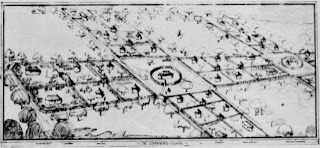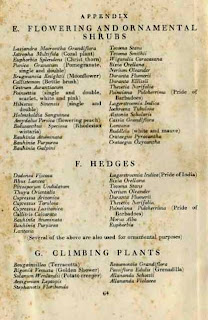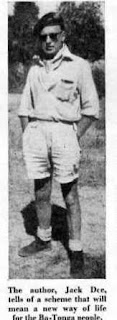 |
| The prince, the governor and the architect |
I feel quite fortunate to have picked up a copy of this slim volume about the establishment of the city of Lusaka, as there don't seem to be a lot of them around. It was published in 1935 to commemorate the official opening of the new capital of Northern Rhodesia, during jubilee week. There are some interesting observations and a number of drawings of the government buildings constructed, as well as an alternative, rejected plan of the city.
"To plan a city on virgin land, to build the nucleus of a capital for a country, is essentially an act of faith, a looking forward to the increase that the years will bring."
So begins this short account of Professor Adshead's plan of the city, and the matter is very much in this vein, about how to cater for the expansion of the city in future, and where to site various facilities so as to benefit residents most. There is a short history of African exploration and we hear the story of how Livingstone's initials 'can still be faintly seen' on a tree on an island on the brink of the falls, carved on the day he reached the falls in 1855. I wonder if there are earlier mentions of this story, which lately seems to be regarded as apocryphal. We are told that the inscription on the tree in Chitambo's village where Livingstone was buried reads LIVINGSTONE - MAY 4 - 1873 - SOUZA - MNIASERE - YCHOPERE. The last three the unnamed author says are 'probably names'.
 |
| An early prospector party |
'From Tanganyika to the Zambezi the country was overrun with Arab slavers, and the warrior tribes ... were fast exterminating those few survivors who the Arabs left.... We are sometimes accused of having with our rapacity ruined and commercialized a golden age of Africa. That age was red with the blood of a carnage that would not have ended as long as a potential slave remained.'
Lusaka, he says, is intended to be both a commercial and administrative capital, succeeding Fort Jameson as capital of N.E. Rhodesia and Kalomo as capital of the North West (up to 1907), and Livingstone, which had become capital in 1911.
 |
| The first secretariat building in Kalomo, 1899 |
'The prevalent idea that the building ... was thought of during the governership of Sir James Maxwell in 1929 is not correct.' because Livingstone was only ever a temporary choice. It was unsuitable due to its distance from large parts of the country (1000 miles from Abercorn in the north, present day Mbala) and its less temperate climate, before the development of the copper belt reinforced the argument.
 |
| Government House, designed by Walcot |
Given that much of the existing development that had taken place was simply along the railway at regular intervals where sidings had been made it was felt necessary to call in an expert, Professor Adshead of London University, and a firm of water engineers, Sir Alexander Binnie Sons & Deacon. As a result of their report the ridge lying to the east of Lusaka was chosen for the important buildings. (The old town of Lusaka at this time lies to the west of the railway station, along the Great North Road.)
 |
The original Lusaka airport, in the town centre,
designed by Norman, Muntz & Dawbarn of Heston.
'If someone arrives at the wrong aeroplane
there is another path' |
Although Lusaka has no river supplying it, the engineers believed bore-holes would be sufficient. And, although we may pine for the beauty of the river in Livingstone, the author explains, Kafue will soon be within easy reach. There is already a landing ground for aeroplanes there.
 |
Gymkhana club ('Lusaka Club')
designed by Flutter |
The area covered by Lusaka is unusually large for its time and population, allowing for growth, and separates civic activity from residential and commercial -
'no untidy mingling'. The chequer-board design of many modern cities is rejected in favour of the crescent and circus. Of course, there are also separate accommodation and trade areas for Africans and Europeans. The shopping area is not yet built, but planned on the site of an old golf course.
The Ridgeway is to be the main artery, only one mile of which has been constructed. The new streets will be 120 feet wide -- not, as some might imagine, to allow an ox cart to turn around, but to allow for cars to park. A site for the cathedral has been set aside at a place where it would 'probably appear as the most important building'. Houses are also being planned to deal with the extremes of temperature as well as mosquitoes, with 'glassed in sleeping porches'. Even built-in garages are provided in officials' houses, one of which is known as the Yodel house, because it is based on one in the Austrian Tyrol. The
 |
| The Secretariat (?) |
 |
| Garden front Government House |
tiles and bricks were made from clay dug near Lusaka, with wood features constructed from local mukwa and Rhodesian mahogany.
The African population is catered for by two classes of accommodation:
personal servants and others, in separate compounds.
'Quarters are only
provided for one unmarried boy on each plot... Thus not only is the
residential area freed from picannins and other manifestations of
domestic untidiness and noise, but an opportunity is afforded to
provide these families with a life of their own'. The 'boys' are
considered to have reached a higher standard of culture and civic
behaviour and will prefer to associate with their fellows. The layout of the compounds hopes to preserve the best features of the African village, with family accommodation in clusters of four units, 'looking into itself and divided by an appreciable space from its neighbour.... The modern village housewife... makes her husband build her a separate kitchen a few yards away', but they can't quite manage that, so subdivided communal kitchens were a compromise. We are told that some women have already made formal paths from their huts to their kitchens.
 |
| The governor's village |
It is very much easier to keep a round hut clean than one with corners and to thatch one.
The question of windows was rather more difficult .. because the African ... does not share the Englishman's passion for fresh air, and if you put an ordinary window in his hut he will inevitably keep it shut or stuff it up with a sack....but many huts in the villages are now being built with very small windows high up in the wall. The compound huts are built to mimic this. Thatch is used for roofs but brick is chosen rather than mud for walls, as more durable. Floors are concrete rather than clay and dung.
Any visitor to Lusaka will have noticed the trees, and much thought was given to them at this time. Adshead had imagined banana trees and palms, but at this height they were not easy to grow. The majority of roads were lined with double rows of trees, some jacaranda, African Flame Tree, or the yellow flowered Markhamia, some mangoes, or wild fig or mahogany, Pride of India, cypress, yellow tecoma or oleander and so the list goes on (see lower down). Even the moringa 'which is said to provide horse-radish from its roots, spinach from its leaves and a flavouring for curries from its pods' is there. And whilst they cannot see the benefits of all this in 1935, we can now enjoy their efforts in many parts of the capital.
The King's birthday in 1935 was chosen as the date of completion. The project, which had been budgeted at £435,000, came in at just £400,000, ahead of schedule.
 |
| The adopted plan |
 |
| The original plan |
It's worth having a look at this
photo stream at the national archives, which shows aerial shots of several of these buildings. They appear to be taken at about the same time. It's a far cry from our city of over 2 million inhabitants today, with 2 hour traffic jams. Lusaka certainly needs an overhaul of its road system now, as well as its water supply.


Here are those plants and trees in full, from the appendix, some indigenous, some imported. I must admit I can't ever recall seeing a sausage tree in Lusaka. I wonder how many of these can still be found. You'll notice also that lantana is on the list, which is now considered a weed by most.
Names in this book:
Most of these are brief mentions. There are a couple of nice tales.
Adshead, Professor
Baker, Sir Herbert
Chaka (Zulu)
Chitambo (Chief)
Chitanda
Chitimukulu (Awemba)
Coillard, Francois (Revd)
Codrington, Robert
Coryndon
Dawbarn, Graham
Flutter, Mr A. T. (A.R.I.B.A.)
Gamitto, Captain
Heal, Messrs of London
Hoogterp, Mr J.A. (F.R.I.B.A.) architect
Johnston, Harry
Kazembe (Chief)
de Lacerda e Almeida, Francisco Jose Maria
Lewanika
Livingstone, David
Lobengula
Mackinnon
Maxwell, Sir James
Moffat, Dr
Monteiro, Major
Mpeseni (Ngoni)
van Oost (Pere)
Pauling, George
Rhodes, Cecil
Sebotoane (Chief)
Sharpe, Alfred
Thomson, Joseph
Uzwangendaba (Ngoni leader)
Walcot, Mr (F.R.I.B.A.)
Williams, Sir Robert
Young
References
Lusaka 1935, Jonathan Cape, private circulation, 1935
North of the Zambezi, Anthony, L.F. G., Northern Rhodesia Information Dept, 1953
 The author, Jack Dee (no, not that one) looks quite the part in his beret. He says
The author, Jack Dee (no, not that one) looks quite the part in his beret. He says By 1959, many of the people have been moved off their land already.
By 1959, many of the people have been moved off their land already. At this stage the operation is proceeding apace, trees are being felled
by chains tied between massive iron balls, dragged behind heavy
vehicles. Animals are fleeing the waters and being trapped (hence 'operation Noah').
At this stage the operation is proceeding apace, trees are being felled
by chains tied between massive iron balls, dragged behind heavy
vehicles. Animals are fleeing the waters and being trapped (hence 'operation Noah'). 






















